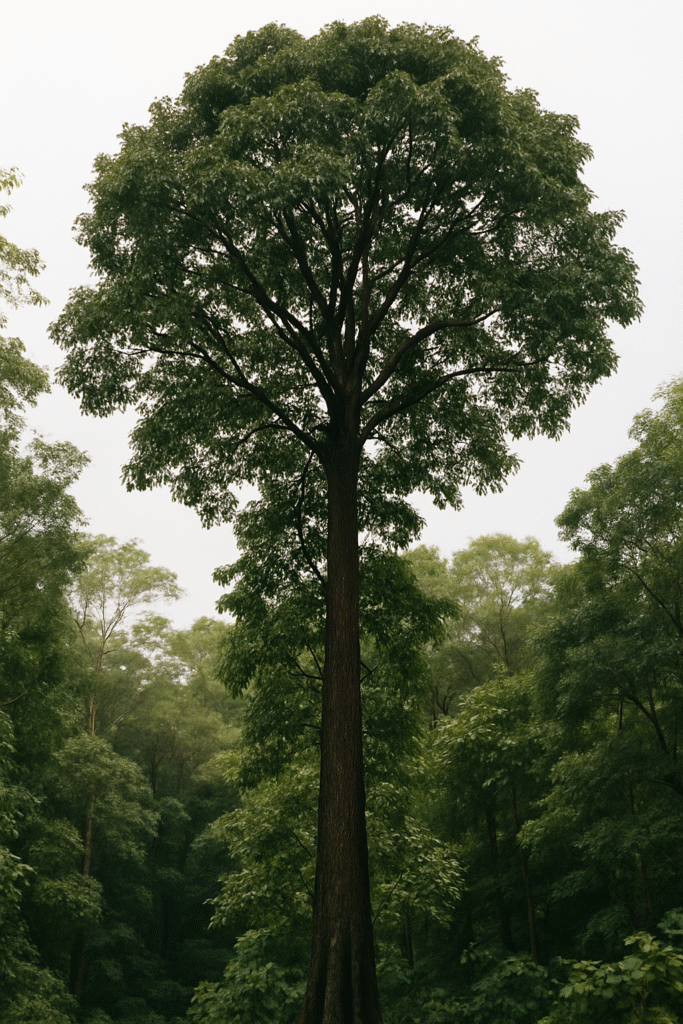The black laurel is a native tree of the Brazilian forest, widely valued for its elegant appearance and exceptionally durable wood. Also known as louro-ferro, brown laurel, or canela-preta, this species belongs to the Lauraceae family—the same family as the culinary bay leaf (Laurus nobilis), although it is a completely different species.
Found primarily in the Atlantic Forest, the black laurel has captured attention not only from the timber industry but also from environmental conservationists, wood artisans, and nature lovers. This article explores the key features, uses, ecological role, and interesting facts about the black laurel, a tree that combines sustainability with high commercial value.
Key Characteristics of the Black Laurel Tree
The black laurel is a medium to large-sized tree, often reaching heights between 15 and 25 meters (49 to 82 feet). Its trunk is tall, straight, and cylindrical, with dark, rough bark. The tree’s leaves are oval-shaped, leathery, and smooth along the edges. Its flowers are small and yellowish-white, and the tree produces fruits that resemble small olives, which are eaten by birds and small mammals.
What truly distinguishes the black laurel is its high-density, dark hardwood, known for its rich brown to grayish tones and well-defined grain. The texture is smooth to medium, and the wood is naturally resistant to moisture, fungi, and termites. These qualities make it ideal for both indoor and outdoor use.
Natural Habitat and Geographic Distribution
The black laurel thrives in the Atlantic Rainforest biome, favoring humid, well-drained soils. It is commonly found in the southeastern and southern regions of Brazil, especially in the states of São Paulo, Minas Gerais, Paraná, Espírito Santo, and Santa Catarina. It can also be seen in transitional zones bordering the Cerrado biome.
While the species is not officially classified as endangered, deforestation and unregulated logging have caused its population to decrease in some areas. For this reason, sustainable forest management and wood certification are essential for preserving this valuable tree species.
Main Uses of Black Laurel Wood
Black laurel wood is categorized as a noble timber and is widely sought after in the woodworking, construction, and design industries. Its durability, visual appeal, and structural stability make it suitable for several high-end applications:
-
Luxury furniture: Tables, chairs, cabinets, and bookshelves made from black laurel exude elegance and strength.
-
Flooring and hardwood panels: Due to its density and resistance to wear, it’s perfect for floors in both residential and commercial settings.
-
Doors and window frames: The wood holds up well to weather changes, making it ideal for outdoor joinery and framing.
-
Interior design features: Wall panels and ceiling beams using black laurel add a warm, rich tone to interiors.
-
Musical instruments and boat components: Some parts of guitars, violins, and light wooden boats are crafted from this hardwood for its acoustics and durability.
There is also ongoing research into the medicinal and antimicrobial properties of the tree’s bark and leaves—traits common among plants in the Lauraceae family.
Cultivation and Sustainable Planting
Black laurel can be propagated through seeds, although germination is slow and requires stable humidity and temperature conditions. As interest in ecological restoration and agroforestry grows, this species is increasingly being included in reforestation and biodiversity projects.
Planting black laurel trees not only helps restore degraded landscapes but also offers economic opportunities. Legal and sustainable timber production from managed forests is becoming an attractive alternative for small and medium-sized rural producers in Brazil.
Ecological Importance
Beyond its commercial use, black laurel plays a significant ecological role. Its fruits serve as a food source for birds, monkeys, and other forest-dwelling animals, helping maintain the local biodiversity. Its dense canopy provides shade and contributes to regulating microclimates and maintaining soil moisture.
In conservation areas and private lands alike, planting native trees like the black laurel helps fight climate change, preserve water resources, and create biological corridors for wildlife. Sustainable use of such species is one of the pillars of responsible forestry.
Interesting Facts About Black Laurel
-
Despite the name “laurel,” this tree is not used in cooking like the bay leaf (Laurus nobilis), although both belong to the same botanical family.
-
Black laurel wood can last for over 25 years outdoors when properly treated.
-
Its distinctive scent is mildly aromatic, characteristic of Lauraceae trees.
-
The dark tones of the wood make it naturally elegant—often requiring no artificial coloring or heavy finishes.
-
It is one of the preferred woods for upscale design and custom furniture due to its balance of beauty and hardness.
Conclusion
The black laurel is a perfect example of how Brazil’s native flora can combine ecological value and economic potential. Its beautiful, long-lasting wood supports local industries, while its presence in the forest contributes to biodiversity and environmental balance.
Whether you’re a nature lover, carpenter, builder, or eco-conscious consumer, the black laurel deserves attention as a sustainable and valuable resource.

And if you love spending time outdoors and want a more comfortable experience while camping, check out this powerful and practical fan:
Learn how Tatajuba’s resilient hardwood is shaping sustainable construction and design around the world.

